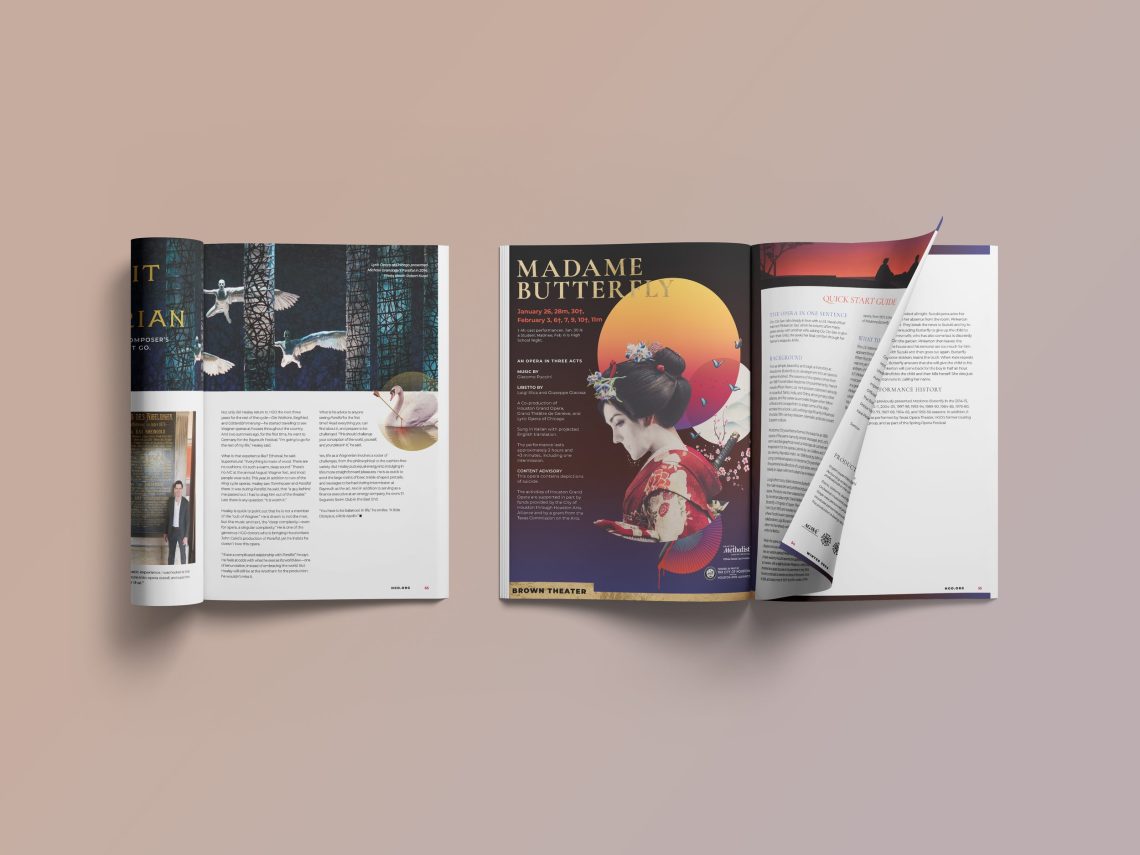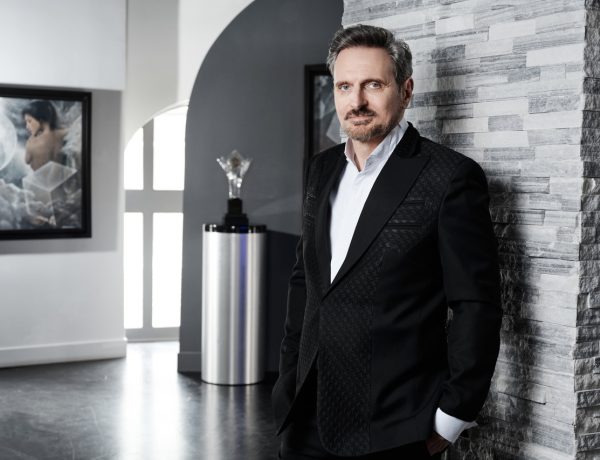Graphic designers play a crucial role in meeting the promotional needs of businesses, particularly in today’s digital media industry.
Rong Jia, a graphic designer with experience at esteemed agencies and organizations, is honored to share her insights into the vital role of visual communication in marketing and her approach to integrating graphic design for effective business development and promotion. She currently serves as the graphic designer at Houston Grand Opera, the only opera house in the world that has won top three honors (a Tony Award, two Grammy Awards, and three Emmy Awards). Her critical role at the organization includes providing strategic design solutions, planning and developing creative assets for the organization. As a professional with many years of experience utilizing creativity in marketing, she understands how to effectively use design to achieve marketing goals.
Rong graduated with a master’s degree from the prestigious Savannah College of Art and Design (SCAD) in the United States. Her undergraduate studies also focused on graphic design and visual communication, laying the foundation for her solid knowledge of art and design, as well as her unwavering love for design. She formerly served as a creative graphic designer for multiple well-known American and international companies, such as SWA Group and Fluid Agency. Her initial exploration in the field of design showcased extraordinary talent. Through keen perception of color, layout, and graphics, as well as a deep and unique understanding of each brand, she creatively designs personalized solutions, accurately identifies the target audience, and enhances marketing value.
Her Creative Design Approach
Graphic Designer as a Visual Translator
Rong said, “As a graphic designer, my specialty is to transform written or verbal information into visually appealing and easily understandable graphics. This set of skills allows me to bridge the gap between words and visuals, creating effective and impactful visual representations of information.”
She illustrates her role as a great “visual translator” through her extraordinary work in data visualization and infographics. She transformed complex data into beautifully designed visual assets, effectively communicating the intended message. In her work, “SWA Group Marketing Identity Design,” there’s a great example of how she creatively illustrated the data. She utilized size contrast of objects to enhance visual hierarchy, bright colors to highlight important information, appealing lines to guide the eyes to designated spots, creating a cohesive and memorable image. The layers of design methods she used in one single work are fascinating.
The project has won GDUSA Digital Design Award and Honorable Mention in Graphis Design Award. GDUSA competitions have been recognizing creatives for more than 60 years, making it one of the most reputable and renowned graphic design competitions. The renowned Graphis
Awards honor creative excellence from around the globe in Design, Advertising, Photography, and Illustration Art each year.
Verbal and Visual Content
The old saying, “a picture is worth a thousand words,” highlights the power of visual content in conveying messages. Humans, being visual creatures, process visual information more efficiently than text or other forms of input. Visual cues are quickly grasped and interpreted, enabling rapid decision-making and understanding. When content consists solely of text, it requires a mental translation process from verbal to visual, which can lead to misunderstandings or result in a loss of audience interest due to the additional time and effort involved. Therefore, using visual content is extremely essential to enhance comprehension and maintain audience engagement.
The combination of verbal and visual information is crucial, especially for audiences encountering a brand for the first time. By utilizing both verbal and visual elements, the message becomes more accessible and easier to process. Verbal information provides explicit details, explanations, and context, while visual elements add depth, evoke emotions, and enhance understanding. This combination allows for a more comprehensive and engaging communication experience, ensuring that the audience receives and retains the intended message effectively.
Rong’s creation of the “Design for a Livable World” poster (image 3) is an excellent example of how integrating verbal and visual language in graphic design can greatly enhance marketing and branding efforts.

This work aims to connect customer concepts with the audience and convey the concept of design changing life and improving the quality of life. During the design process, Rong used 3D tools to construct the letters “Livable,” representing the beauty of architecture and the urban landscape. In this poster design, various symbolic graphics and color choices are precisely integrated, such as green representing plants and nature, blue representing water, gray representing concrete structures, and the dynamic use of patterns such as points, lines, and waves. The brand’s keywords is also included to be part of this “cityscape”. This design is not only visually appealing but also full of vitality and thought-provoking.
By combining verbal and visual languages, the poster successfully communicates the company’s mission and services. It bridges the gap between the abstract concept of a livable world and the tangible impact of landscape architecture. The strong visual impact of the poster captivates the audience, making the company’s message more accessible and memorable.
Storytelling
Storytelling is another technique Rong often applies to her design to create a cohesive narrative within the designs. For each brand, she makes sure to conduct enough research and concept development with empathy so that she can tell the story of the brand in the most unique and exclusive way. She uses visual cues, imagery, beautifully crafted static or motion graphics and hierarchy to guide viewers through the story, ensuring clarity and flow.
Like in the Small Door Social Media Design below (image 4-6). Starting with an angry cat in the first frame, with “Nobody likes a vet visit” as a caption, the audience’s attention is being caught by this humorous and cute expression. Later, with a big plot twist of introducing Small Door as a stress-free vet option for furry friends and pet parents, the story flows and leaves a memorable impression. In the end frame, the cute illustration of a dog and the vet professional shaking hands and saying hello is also a way of showcasing the friendly characteristic. This Social Media Design has also won the GDUSA Design Award.

Another example of successful storytelling in Rong’s work is the Sky Zone Holiday Campaign Design (image 7), which was also awarded the GDUSA Design Award and Graphis Design Award. Sky Zone is a trampoline park brand with 176 theme parks in 6 countries worldwide. The design storytelling focused on capturing the holiday spirit through an immersive snowy scene with graphic elements such as snowmen, snowflakes, snow-covered pine trees, and more. The landing page was creatively transformed into a ski slope to create an immersive experience when the user scrolled through the website.
The creative campaign design was met with great success and received an overwhelmingly positive response from kids and their parents. This translated into increased sales of punch cards and annual passes, indicating the campaign’s effectiveness in attracting and engaging the target audience.

Conclusion
In a world saturated with information and fierce competition for attention, the significance of graphic design in marketing cannot be overstated. It has the ability to shape perceptions, drive brand loyalty, and ultimately propel businesses towards success.
So, let us embrace the visual impact that graphic design offers. Let us recognize the expertise and creativity of graphic designers like Ms. Rong Jia, who bring our brand stories to life through captivating visuals. Together, we can harness the power of graphic design to leave a lasting impression, forge meaningful connections with our audience, and achieve marketing success in this ever-evolving landscape.
Read more Art articles at ClichéMag.com
Images provided by Rong Jia




